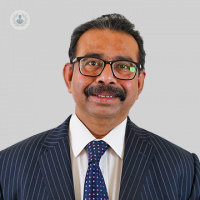What is an umbilical hernia and does it need surgery?
Autore:An umbilical hernia happens when there is a defect in the abdomen wall, which the intestine and the fats around the intestine (omentum) can push through, appearing as a lump. An umbilical hernia can be present in infants, but it can also be present in any age group. Leading surgeon Mr Barun Majumder explains how to spot umbilical hernia symptoms, and when the hernia might need surgical treatment.

How common are umbilical hernias?
Umbilical hernias are actually three times more common in women than men when they occur in adulthood. However, among children, the ratio is equal, occuring in both boys and girls at the same rate. Umbilical hernias are also noted to be very common in children of African descent.
What causes umbilical hernias?
The cause of umbilical hernia varies between children and adults. During pregnancy mother and baby are connected by the umbilical cord, which provides nutrition and carries oxygen from the mother to her baby. After birth, this tube closes spontaneously, but if it the tube does not close naturally, then an infantile or congenital umbilical hernia can present.
In adults, however, this scar or the weakness may reopen due to increase raised pressure inside the tummy: for example, during strenuous activities or while lifting heavy weights. This then it presents as an acquired adult umbilical hernia. This type of pressure or activity can also cause another related type of hernia that occurs around the belly button, which is called paraumbilical hernia.
In adults, umbilical or paraumbilical hernia can also be caused by other factors, such as multiple pregnancy, excessive fluid in the tummy (a possible side effect of liver conditions), or a tube inserted into the bellybutton for peritoneal dialysis.
What are the symptoms of an umbilical hernia?
The symptoms of an umbilical hernia are more or less similar, whether in infants or adults.
In infants, a little lump near the belly button may appear when the baby's crying or laughing. They also may cry without any obvious motive, because of the pain they feel at the belly button.
In adults the symptoms may range from simple discomfort around the belly button to pain felt around the belly button when lifting heavy weights and heavy objects. Adults may may also notice a lump appear on the belly button. However, it is worth noting that most a lot of the people don't notice the lump at the belly button, and it is often spotted by their GP during a routine clinical examination.
How is an umbilical hernia treated?
In infants, an umbilical hernia usually closes off by about the age of 18 months. In cases where the hernia does not close off, surgery is usually performed after the child is over the age of 4.
An umbilical hernia can be treated in different ways: through open surgery, keyhole surgery (which we call laparascopic surgery) or through conservative management. In open surgery, the surgeon opens up the hernia by making a small incision around the belly button and approaching the hernia. The content of the hernia is then reduced, and a mesh, which is like a plug, is placed to seal the hernia.
In keyhole or laparoscopic surgery, the operation is performed by the surgeon first making two small holes, through which a camera is inserted allowing the surgeon to see the hernia or the defect. The surgeon will then reduce everything inside the hernia and then insert a mesh at the back of the hole so that it can be sealed.
Finally, another method of 'treatment' is doing nothing at all - what we call conservative treatment. This method is generally indicated in very high-risk patients where the hernia is not causing any symptoms. In cases like this, it is often better to simply manage the hernia over time with ongoing monitoring from the doctor.
If would like to know more about inguinal hernia repair, make an apointment to see a specialist.



